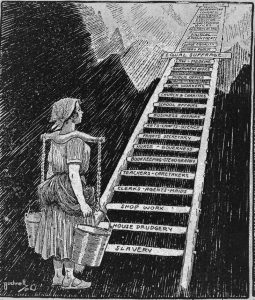
On April 29, 2019, I moderated a panel discussion for the State Bar of Wisconsin’s Diversity Counsel Program titled “Closing the Gender Leadership Gap.” The following statistics were shared at the program. According to a study by the American Bar Association, “A Current Glance at Women in the Law,” half of the students graduating from law school with a J.D. are women. Yet, only 22.7% of law firm partners are women, 22% of state court judges are women, and 26.4% of Fortune 500 general counsel positions are held by women. A significant barrier for women in the workplace is implicit bias. After serving on this panel, I was curious to explore how the concept of implicit bias might contribute to the gender leadership gap in the legal profession.
Implicit bias is the term that describes how the subconscious mind categorizes people. The concept was first developed by psychologists Mahzarin Banaji and Anthony Greenwald in the 1990s. Through the use of implicit association tests (“IAT”) Banaji and Greenwald evaluated the time it took for a participant to categorize concepts such as family or career with gender. The quicker the applicant could categorize concepts, the stronger the implicit association. The most frightening aspect of implicit bias is that a person may be consciously opposed to gender discrimination but may unknowingly discriminate against women due to an implicit bias that exists only in the subconscious mind.
Studies suggest that implicit bias may play a role in explaining why men are systematically preferred for positions over women. For example, a Yale study demonstrated a statistically significant preference for men in the field of science. The study involved sending a fictional resume to 100 faculty members at top universities. The only difference was that 50 fictional students were named John, while the other 50 fictional students were named Jennifer. Even though the candidates had identical experience and qualifications, faculty members were more likely to find John competent and were more likely view him as a suitable candidate for lab positions. Furthermore, faculty members were more likely to mentor John and would offer him a higher salary than Jennifer. Another, study by Cecilia Rouse and Claudia Goldin demonstrated woman’s chances of advancing through the preliminary rounds of orchestra auditions increased 50 percent when a screen blinded the judges from knowing her gender.
These and other studies suggest that a wide array of professions, including the legal profession, are systematically discriminating against women in the hiring process. It is unlikely that the universities and orchestras explicitly prefer male candidates to their female counterparts. The more plausible explanation is that those in the position of selecting candidates have unknowingly allowed implicit bias to affect hiring decisions.
Similarly, male preference in promotion decisions can result in devastating ripple effects over time. A study using computer simulation to generate the real world effect of gender bias suggests that the consequence of even a 1% bias favoring promotion of men at early career stages could result in men holding 65% of leadership positions downstream. The same study demonstrated that a 5% bias favoring the promotion of men at early career stages resulted in men holding 71% of leadership positions downstream. Thus, “by taking into account the relative scarcity of very senior-level positions in organization as well as the weight accorded early career performance, a little bias hurt women a lot.” As I enter my ninth year of practice, I am grateful for my past and current mentors, who recognize my competence, challenge me, and afford me great responsibility. Yet, as I progress through my career, the frequency with which I encounter women litigators at my level of practice diminishes.
As a 2016 ABA study, “You Can’t Change What You Can’t See” explained, women and people of color face challenges in the workplace not experienced by white men. For example, most people commonly associate lawyers with white men. Lawyers who don’t fit into that category report having to set forth more evidence of competence to be accepted. Women of color often face the greatest challenge in this and other arenas.
Another particularly difficult challenge women face is learning to strike a balance between being assertive and being viewed as overly aggressive or shrill. As the 2016 ABA study concluded:
both women and people of color have been invited into today’s legal workplaces, but the kinds of behaviors white men exhibit in order to get ahead are less likely to be accepted from other groups. Instead, women and people of color are more likely than white men to report that they are expected to be ‘worker bees’ who keep their heads down but do not seek the limelight.
For litigators, such as myself, this task can become daunting when dealing with a difficult witness during trial. Jury decisions are often influenced based upon their general like or dislike of counsel. For women, it’s a thin line between strong advocacy and being unlikable.
The effects of implicit bias will not be mitigated overnight. The first step is to recognize its existence. When selecting this topic, I decided to take an IAT on gender. The test asked me to group concepts such as salary or wedding with male or female names such as John or Emily. I took the test three times, and three times the test revealed that I have a strong association of men with the concept of career and women with concept of family. As a career woman, a feminist, and a progressive, I was shocked by the results. While controversy exists over the efficacy of IATs, if Banaji and Greenwald are right, then I am implicitly gender biased. In their book, “Blindspot: Hidden Biases of Good People,” Banaji and Greenwald speak at length about the tension people feel when their implicit biases do not reflect their consciously held beliefs. Most people, such as I, are disturbed to learn about their hidden bias against groups to which they belong. In fact, participants often question the validity of the tests when confronted with undesirable results.
Unfortunately, it is difficult to retrain our brains and reverse the effect of implicit bias. Bypassing bias is sometimes possible through blinding, such as erecting a screen between candidates and judges in the orchestra studies. However, the ability to manipulate circumstances in this manner is not always possible. The most practical solution is to remain objective when interacting with evaluating others. When determining whether to hire a candidate, consider concrete strengths and weaknesses and stay away from gut decisions. Consider structuring performance evaluations on objective versus subjective standards. Remain mindful of who you choose to mentor, who you choose to give meaningful projects to, and why you have made those choices. Most importantly, consistently question yourself. Did I make that judgment on merit, or is there something else going on? If we all ask these questions, we can take a step toward mitigating implicit bias.

